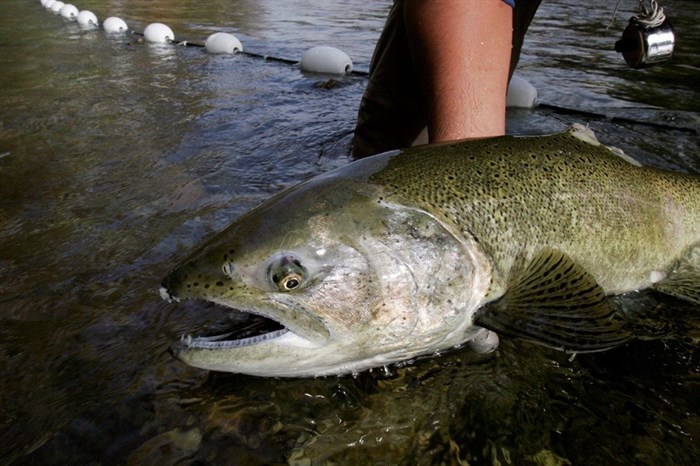
An adult Okanagan chinook salmon.
Image Credit: FACEBOOK/Okanagan Nation Alliance
September 16, 2024 - 6:00 PM
For the first time in known recent history, a lone adult Okanagan summer chinook salmon successfully made its way home to k?úsx?nítkw (Okanagan Lake) from the ocean last week.
The fish’s roughly 1,000-kilometre migration marks a “big milestone” for the syilx Okanagan Nation’s efforts to restore the species to one of its former habitats, the Okanagan Nation Alliance (ONA) proclaimed in a Facebook post last Wednesday — a day after its scientists spotted the lone fish.
ONA fisheries biologist Elinor McGrath told IndigiNews that the five-year-old fish had been raised at the kl cp??lk? stim? hatchery before making its migration journey — from the Okanagan Basin to the Pacific Ocean and back.
She said the event has buoyed longstanding hopes to re-populate the area with chinook. For many years, she said, the vast majority of migrating fish could only reach just north of Oliver because of dams and other blockages.
“You really do realize that you’re achieving something,” McGrath said. “Hopefully, this is just the start of many more things to come.”
The hatchery was built 10 years ago to help restore the historical range and population of salmon throughout the Okanagan watershed — including into the 135-kilometre-long k?úsx?nítk? — and parts of the Columbia River Basin.
The project is part of the Okanagan Chinook Restoration Program, which has released tens of thousands of juvenile chinook into local waterways since 2017. But ONA’s proposals to restore chinook to their historic habitats date back to 1997.
The individual chinook observed returning last week had been released four years ago, south of the lake at the Okanagan River, at release sites in either Oliver or sx???x??nitk? (Okanagan Falls), McGrath noted.
It had been tagged with a small microchip used to uniquely identify individual fish — known as Passive Integrated Transponders (PITs) — prior to its release. A monitoring device detected its return when it swam up a fish ladder at the Penticton Dam.
“It’s just one fish,” McGrath said, “but hopefully that’s a sign of many more to come down the road.”
‘This is such a big deal’
Two types of Okanagan chinook — ntytyix (spring chinook) and sk’lwist (summer chinook) — are endangered, McGrath explained.
Generally each year, fewer than 100 adult chinook return to spawn on the Canadian end of the Okanagan River, which feeds into k?úsx?nítk?.
sk’lwist typically have a four-to-five-year life cycle, compared to just four years for ntytyix, according to the ONA’s Okanagan Chinook Restoration Program’s website. Once they reach adulthood, sk’lwist swim to the Okanagan River from the Pacific Ocean through the “U.S.” in July or August, spawning in the river’s mainstem in October.
Meanwhile, adult ntytyix return to the river from the ocean in May or June, where they spawn in early September in tributaries of the Okanagan Basin.
“Both of them are in really depressed abundance,” McGrath said. “But the ONA has been working on rebuilding these stocks, based on the guidance from knowledge holders and Elders in the community.”
ntytyix (Chief salmon) has been an integral food source and vital cultural icon for the syilx Okanagan Nation for thousands of years.
Central to many of the Nation’s captik?l (syilx oral teachings and principles), ntytyix is one of the Four Food Chiefs who helped determine how the people-to-be would live, and what they would eat.
As a result, chinook hold a “really special status and significance” for sylix people, McGrath said.
“That’s also why this is such a big deal to restore chinook to their former range.”
‘We are thrilled the chinook have returned’
The ONA lauded the lone chinook’s return home as a watershed moment for the nation’s years-long recovery efforts.
“We are thrilled that the chinook have returned to Okanagan Lake,” said a Facebook post from ONA on Sept. 11. “This is a big milestone for our program to restore the population to their former range.”
The loss of chinook and other fish stocks in the Okanagan watershed followed numerous dams being built downstream, as well as engineering efforts to straighten and widen the river in places — known as channelization. Industrial agriculture over the last century also played a role in depleting marine populations.
Similar to the challenges faced by sc?win (Okanagan sockeye salmon), McGrath said migrating chinook have been blocked by dams on the Okanagan River, specifically the McIntyre and Skaha dams, preventing them from returning to the upper Okanagan River watershed.
“The odd one would be spotted here and there,” she noted, “but never a whole lot of them.”
But thanks to decades of dedicated efforts by the Nation to create safe swimming passages past dams to restore salmon populations, the fish are finally returning.
“Sometimes it can be disheartening to see just a few fish come back,” McGrath said, “even though so many people work so hard on this all year long.
“It’s so amazing to see that what we’re doing (is paying off) — we’re working so hard.”
— This story was originally published by IndigiNews.
News from © iNFOnews, 2024